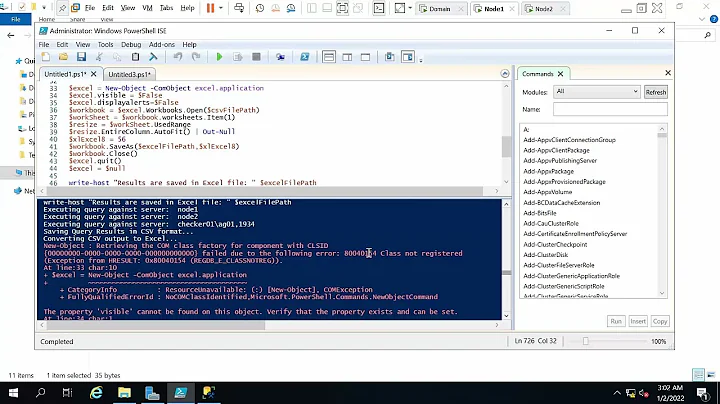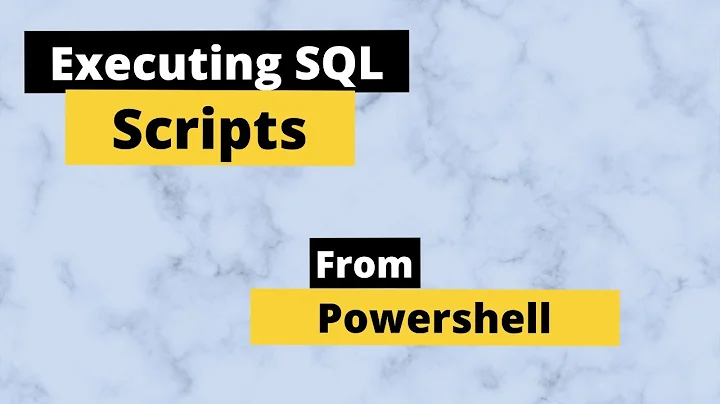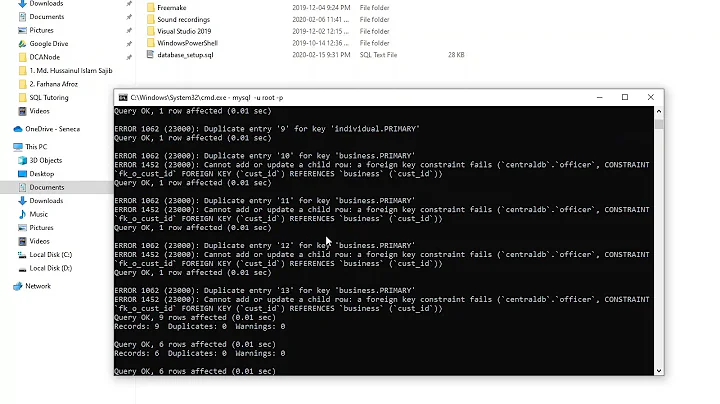How to execute .sql file using powershell?
Solution 1
Try to see if SQL snap-ins are present:
get-pssnapin -Registered
Name : SqlServerCmdletSnapin100
PSVersion : 2.0
Description : This is a PowerShell snap-in that includes various SQL Server cmdlets.
Name : SqlServerProviderSnapin100
PSVersion : 2.0
Description : SQL Server Provider
If so
Add-PSSnapin SqlServerCmdletSnapin100 # here lives Invoke-SqlCmd
Add-PSSnapin SqlServerProviderSnapin100
then you can do something like this:
invoke-sqlcmd -inputfile "c:\mysqlfile.sql" -serverinstance "servername\serverinstance" -database "mydatabase" # the parameter -database can be omitted based on what your sql script does.
Solution 2
Quoting from Import the SQLPS Module on MSDN,
The recommended way to manage SQL Server from PowerShell is to import the sqlps module into a Windows PowerShell 2.0 environment.
So, yes, you could use the Add-PSSnapin approach detailed by Christian, but it is also useful to appreciate the recommended sqlps module approach.
The simplest case assumes you have SQL Server 2012: sqlps is included in the installation so you simply load the module like any other (typically in your profile) via Import-Module sqlps. You can check if the module is available on your system with Get-Module -ListAvailable.
If you do not have SQL Server 2012, then all you need do is download the sqlps module into your modules directory so Get-Module/Import-Module will find it. Curiously, Microsoft does not make this module available for download! However, Chad Miller has kindly packaged up the requisite pieces and provided this module download. Unzip it under your ...Documents\WindowsPowerShell\Modules directory and proceed with the import.
It is interesting to note that the module approach and the snapin approach are not identical. If you load the snapins then run Get-PSSnapin (without the -Registered parameter, to show only what you have loaded) you will see the SQL snapins. If, on the other hand, you load the sqlps module Get-PSSnapin will not show the snapins loaded, so the various blog entries that test for the Invoke-Sqlcmd cmdlet by only examining snapins could be giving a false negative result.
2012.10.06 Update
For the complete story on the sqlps module vs. the sqlps mini-shell vs. SQL Server snap-ins, take a look at my two-part mini-series Practical PowerShell for SQL Server Developers and DBAs recently published on Simple-Talk.com where I have, according to one reader's comment, successfully "de-confused" the issue. :-)
Solution 3
if(Test-Path "C:\Program Files\Microsoft SQL Server\MSSQL11.SQLEXPRESS") { #Sql Server 2012
Import-Module SqlPs -DisableNameChecking
C: # Switch back from SqlServer
} else { #Sql Server 2008
Add-PSSnapin SqlServerCmdletSnapin100 # here live Invoke-SqlCmd
}
Invoke-Sqlcmd -InputFile "MySqlScript.sql" -ServerInstance "Database name" -ErrorAction 'Stop' -Verbose -QueryTimeout 1800 # 30min
Solution 4
Here is a function that I have in my PowerShell profile for loading SQL snapins:
function Load-SQL-Server-Snap-Ins
{
try
{
$sqlpsreg="HKLM:\SOFTWARE\Microsoft\PowerShell\1\ShellIds\Microsoft.SqlServer.Management.PowerShell.sqlps"
if (!(Test-Path $sqlpsreg -ErrorAction "SilentlyContinue"))
{
throw "SQL Server Powershell is not installed yet (part of SQLServer installation)."
}
$item = Get-ItemProperty $sqlpsreg
$sqlpsPath = [System.IO.Path]::GetDirectoryName($item.Path)
$assemblyList = @(
"Microsoft.SqlServer.Smo",
"Microsoft.SqlServer.SmoExtended",
"Microsoft.SqlServer.Dmf",
"Microsoft.SqlServer.WmiEnum",
"Microsoft.SqlServer.SqlWmiManagement",
"Microsoft.SqlServer.ConnectionInfo ",
"Microsoft.SqlServer.Management.RegisteredServers",
"Microsoft.SqlServer.Management.Sdk.Sfc",
"Microsoft.SqlServer.SqlEnum",
"Microsoft.SqlServer.RegSvrEnum",
"Microsoft.SqlServer.ServiceBrokerEnum",
"Microsoft.SqlServer.ConnectionInfoExtended",
"Microsoft.SqlServer.Management.Collector",
"Microsoft.SqlServer.Management.CollectorEnum"
)
foreach ($assembly in $assemblyList)
{
$assembly = [System.Reflection.Assembly]::LoadWithPartialName($assembly)
if ($assembly -eq $null)
{ Write-Host "`t`t($MyInvocation.InvocationName): Could not load $assembly" }
}
Set-Variable -scope Global -name SqlServerMaximumChildItems -Value 0
Set-Variable -scope Global -name SqlServerConnectionTimeout -Value 30
Set-Variable -scope Global -name SqlServerIncludeSystemObjects -Value $false
Set-Variable -scope Global -name SqlServerMaximumTabCompletion -Value 1000
Push-Location
if ((Get-PSSnapin -Name SqlServerProviderSnapin100 -ErrorAction SilentlyContinue) -eq $null)
{
cd $sqlpsPath
Add-PsSnapin SqlServerProviderSnapin100 -ErrorAction Stop
Add-PsSnapin SqlServerCmdletSnapin100 -ErrorAction Stop
Update-TypeData -PrependPath SQLProvider.Types.ps1xml
Update-FormatData -PrependPath SQLProvider.Format.ps1xml
}
}
catch
{
Write-Host "`t`t$($MyInvocation.InvocationName): $_"
}
finally
{
Pop-Location
}
}
Solution 5
Here's a light weight approach for simple scripts that requires no additional tools / setup / PowerShell add-ons.
$conn = New-Object System.Data.SqlClient.SqlConnection
$conn.ConnectionString = $connectionStringGoesHere
$conn.Open()
$content = Get-Content $scriptFileNameGoesHere
$cmds = New-Object System.Collections.ArrayList
$cmd = ""
$content | foreach {
if ($_.Trim() -eq "GO") { $cmds.Add($cmd); $cmd = "" }
else { $cmd = $cmd + $_ +"`r`n" }
}
$cmds | foreach {
$sc = New-Object System.Data.SqlClient.SqlCommand
$sc.CommandText = $_
$sc.Connection = $conn
$sc.ExecuteNonQuery()
}
Related videos on Youtube
Samselvaprabu
I am mainly working as a Build and integrator. I am maintaining ESXi servers and doing little bit of Configuration management activities (Base Clearcase and clearcase UCM) as every build and integrator.
Updated on July 05, 2022Comments
-
Samselvaprabu almost 2 years
I have a .
sqlfile. I am trying to pass connection string details through a Powershell script and invoke an.sqlfile.I was searching and came up with a cmdlet related to
Invoke-sqlcmd. While I was trying to find a module corresponding to SQL, I did not find any one in my machine.Should I install anything in my machine (the machine already has SQL Server Management Studio 2008 R2) to get the modules or is there any easy way to execute
.sqlfiles using Powershell? -
M.C.Rohith almost 12 yearsAn addition to this for SQL Server 2012, use SqlServerCmdletSnapin110 and SqlServerProviderSnapin110 for registering.
-
Samselvaprabu almost 12 years@M.C.Rohith: Thanks for your value addition. Really an useful information
-
 workabyte about 10 yearsJust an FYI as im sure many people stumble onto the question.With the newer versions of SQL they have sqlps. you can just add Import-Module “sqlps” -DisableNameChecking to your script
workabyte about 10 yearsJust an FYI as im sure many people stumble onto the question.With the newer versions of SQL they have sqlps. you can just add Import-Module “sqlps” -DisableNameChecking to your script -
 CB. almost 10 years@workabyte Have you read this answer below: stackoverflow.com/a/10923160/520612 ?? ;)
CB. almost 10 years@workabyte Have you read this answer below: stackoverflow.com/a/10923160/520612 ?? ;) -
 workabyte almost 10 years@CB. lol nope thats why i put the comment here, this answer is at the top and has a lot of votes so i added the comment somewhere people would see it unlike the answer below. Thanks for pointing it out lmao
workabyte almost 10 years@CB. lol nope thats why i put the comment here, this answer is at the top and has a lot of votes so i added the comment somewhere people would see it unlike the answer below. Thanks for pointing it out lmao -
thomasb about 9 yearsNote that you can now download the SQLPS module from MS ; with
PowerShellTools.msi, there are a x86 and a x64 version. -
 qJake over 8 yearsPSA: For newer versions of PowerShell, you may want to try
qJake over 8 yearsPSA: For newer versions of PowerShell, you may want to tryImoprt-Module SQLPSinstead, orGet-Module -List | ? Name -eq sqlpsto see if you have one or more SQLPS modules available to import. -
 wut-excel over 6 years
wut-excel over 6 yearsGet-Module -ListAvalable>> a correct command isGet-Module -ListAvailable. -
LeBleu over 5 yearsTo use PowerShell with SSMS 17 or later, install it from the PowerShell Gallery with
Install-Module -Name SqlServer -
 Darrin over 2 yearsI have "Microsoft SQL Server 2019" installed, and find that you do NOT refer to 'SQLPS' anymore, instead, to import the module: Import-Module sqlserver -DisableNameChecking
Darrin over 2 yearsI have "Microsoft SQL Server 2019" installed, and find that you do NOT refer to 'SQLPS' anymore, instead, to import the module: Import-Module sqlserver -DisableNameChecking







